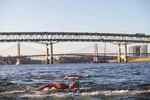
John Rosman / OPB
The Willamette River twists south to north, spanning half the state and reaches two-thirds of its population. It's the country's 13th largest waterway by water volume and is home to a diverse ecosystem.
Through its history, the Willamette has faced a long list of environmental challenges. One of the greatest is thanks to the state's largest city. The Portland Harbor, a 10-mile industrial stretch from the Fremont Bridge to Sauvie Island, was declared a Superfund site in 2000.
It's fair then for your friends to be grossed out by the prospect of taking a dip with the picturesque Portland skyline in the background. But state officials disagree.
OPB News reporter Amelia Templeton talked with the Oregon Department of Environmental Quality and the Oregon Health Authority about the river earlier this year. Both organizations say around Portland, the Willamette is clean enough to swim, though they do suggest showering afterward.
“Doug Drake has worked at DEQ on restoring the lower Willamette and monitoring water quality there for more than 20 years. He said swimming is safe.
We do see pesticides. We do see heavy metals and some organic pollutants, but generally at really low levels," he said.
[But even at the Superfund site], the Oregon Health Authority concluded it's safe to swim. That's because the toxic pollutants aren't floating in the water, but lying in the sediment at the bottom of the river.
He added that exposure to bacteria like E. coli is the greatest health concern to people swimming in the river. The main source of bacteria used to be sewage that overflowed into the river almost every time it rained. Now, Drake said a billion-dollar pipe project prevents most of those overflows.”
Still it's a river. There are two seasonal factors to keep in mind. In winter, after a large storms, sometimes bacteria from sewer systems flow at harmful levels in the rivers. In summer, there can be algal blooms that occur due to warm water.
Algal blooms are in full-effect this summer. In fact, one has become the largest bloom on the West Coast in over decade. It's led to significant closures of commercial crab and shellfish harvesting up and down the coast.
These blooms don't usually pop-up in rivers, due to the current. But in the Willamette, the slow-moving Ross Island Lagoon has been experiencing them.
Before planning your river adventure, check out the Willamette River Recreation Index. There they monitor the water quality and post the results online. For algal blooms, check out this map too.
